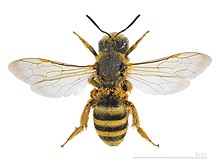Halictidae
| Halictidae | |
|---|---|
 |
|
| Halictus scabiosae - MHNT | |
| Scientific classification | |
| Kingdom: | Animalia |
| Phylum: | Arthropoda |
| Subphylum: | Hexapoda |
| Class: | Insecta |
| Order: | Hymenoptera |
| Suborder: | Apocrita |
| Superfamily: | Apoidea |
| Family: |
Halictidae Thomson, 1869, nom. protect. |
| Subfamilies | |
The Halictidae is the second largest family of Apoidea bees. Halictid species occur all over the world and are usually dark-colored and often metallic in appearance. Several species are all or partly green and a few are red; a number of them have yellow markings, especially the males, which commonly possess yellow faces, a pattern widespread among the various families of bees.
They are commonly referred to as "sweat bees" (especially the smaller species), as they are often attracted to perspiration. They are likely to sting only if disturbed; the sting is minor.
Most halictids nest in the ground, though a few nest in wood, and they mass-provision their young (a mass of pollen and nectar is formed inside a waterproof cell, an egg laid upon it, and the cell sealed off, so the larva is given all of its food at one time, as opposed to "progressive provisioning", where a larva is fed repeatedly as it grows, as in honey bees). All species are pollen feeders and may be important pollinators.
Many species in the subfamily Halictinae are eusocial at least in part, such as Lasioglossum malachurum or Halictus rubicundus, with fairly well-defined queen and worker castes (though not the same as the caste system in honey bees), and certain manifestations of their social behavior appear to be facultative in various lineages. Those species who do not have a permanent, rigid, division of labor, such as Lasioglossum zephyrum, are considered primitively eusocial. Another example of a primitive eusocial bee species from this family is the Halictus ligatus species, for which aggression is one of the most influential behavioral attitudes for establishing hierarchy and social organization within the colony. Primitively eusocial species such as these provide insight into the early evolution of eusociality.Halictus sexcinctus, which exhibits social, communal, and eusocial organization, provides insight into the evolutionary reversal of eusociality. Phylogenetic data from this species suggests that a communal strategy serves as a transitional step between eusociality and a reversion back to solitary nesting.
...
Wikipedia
